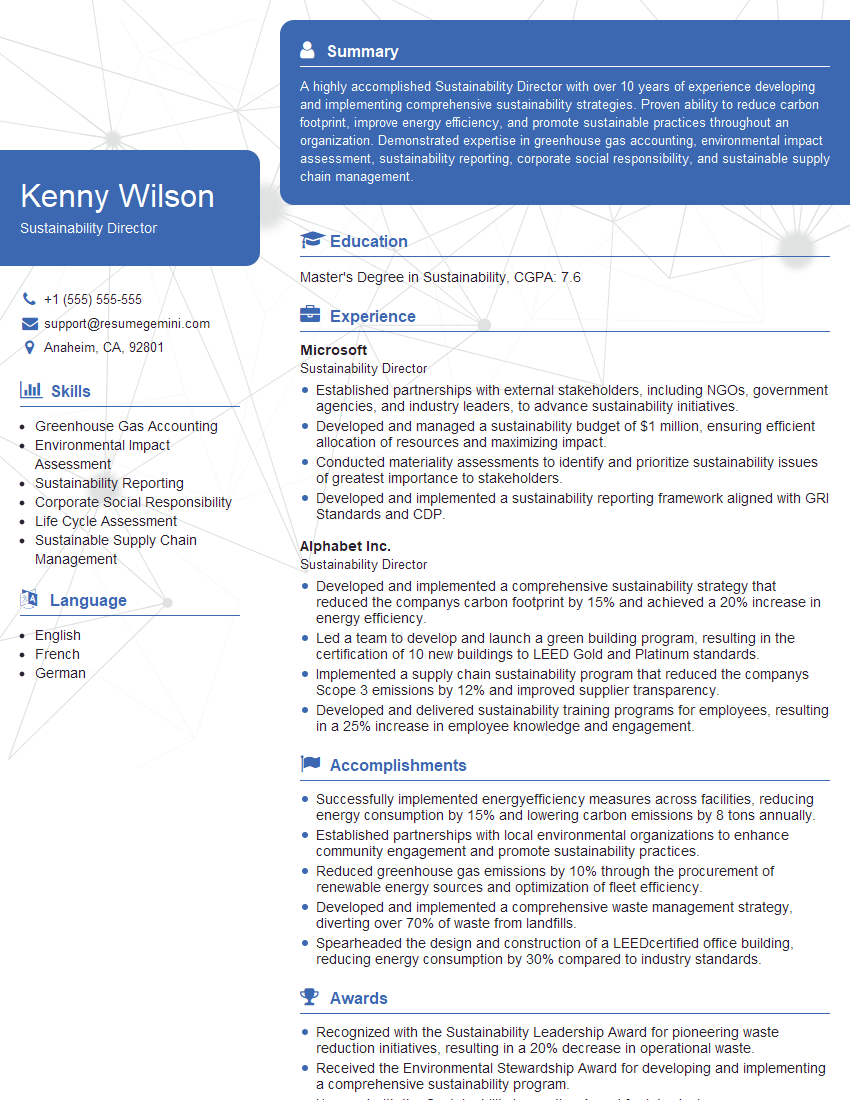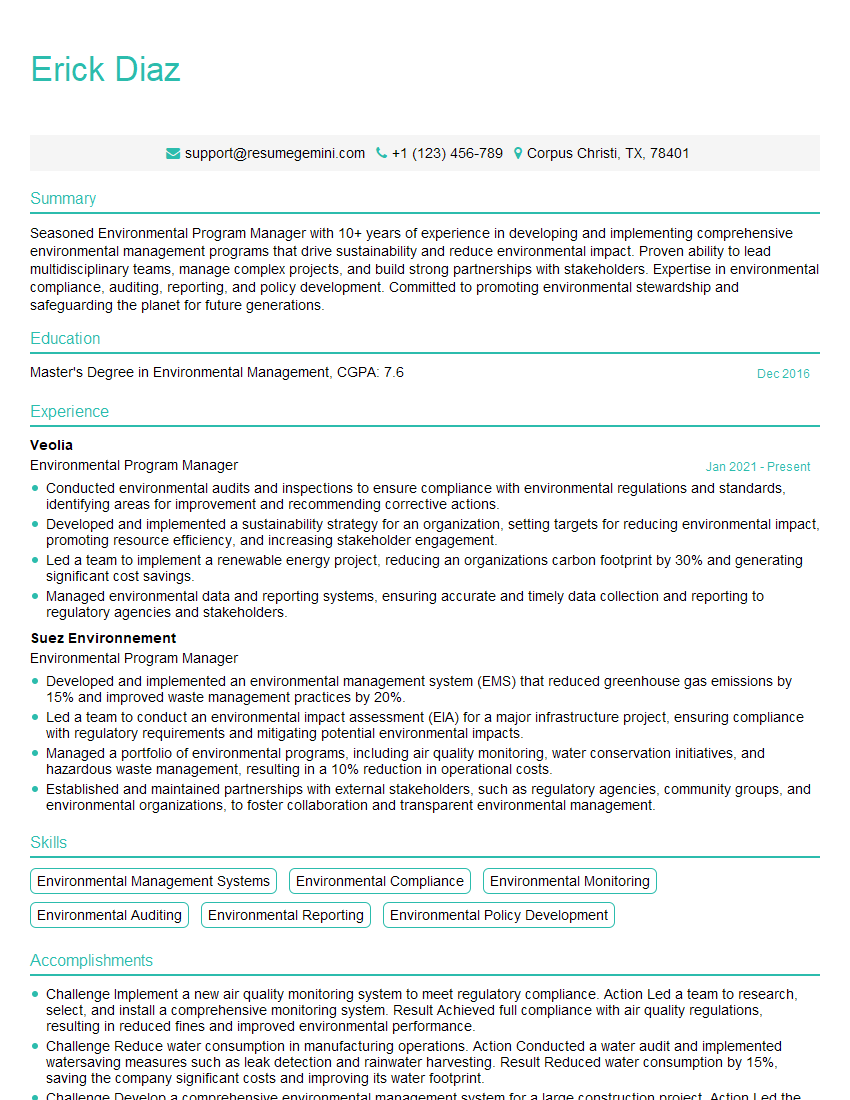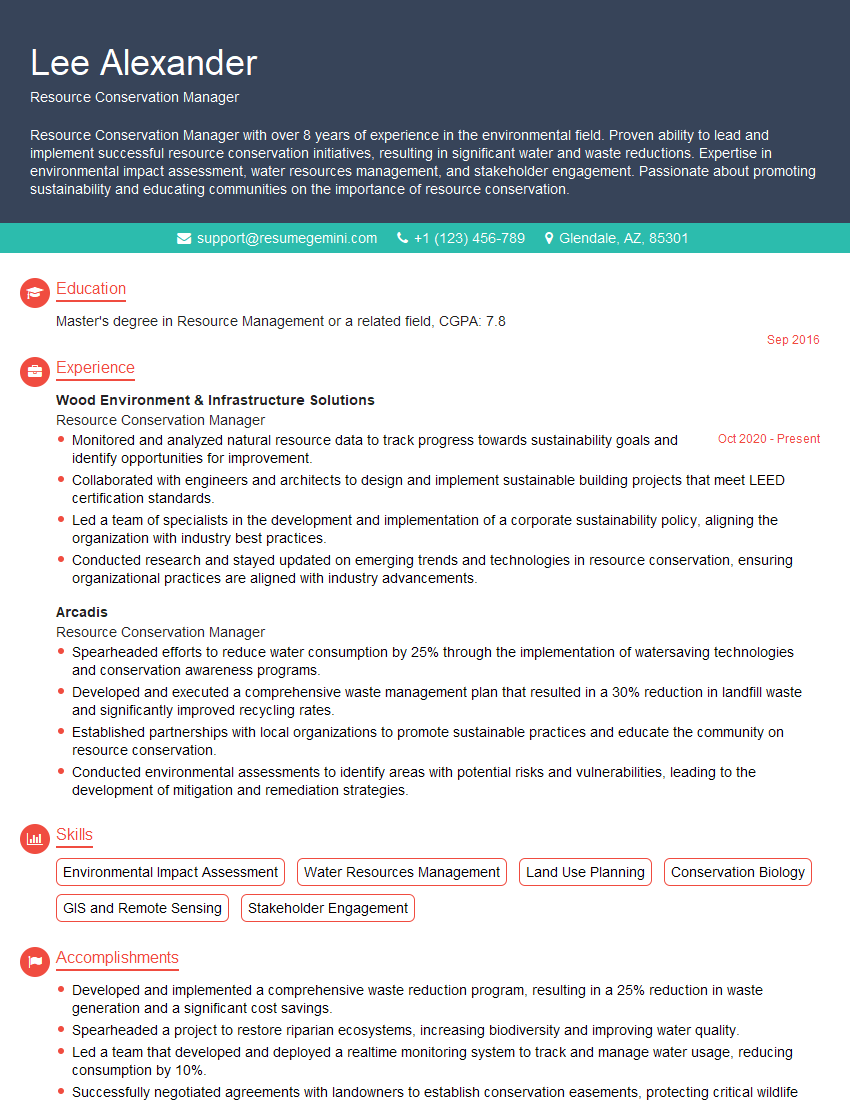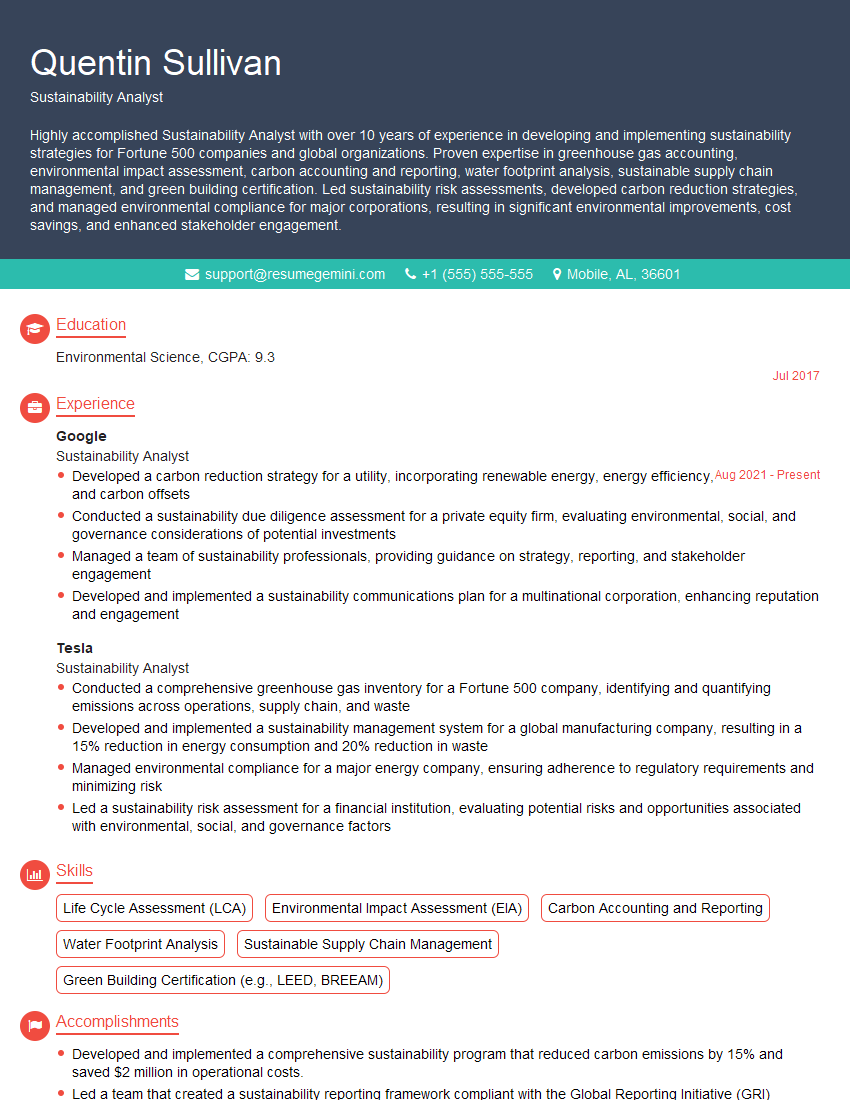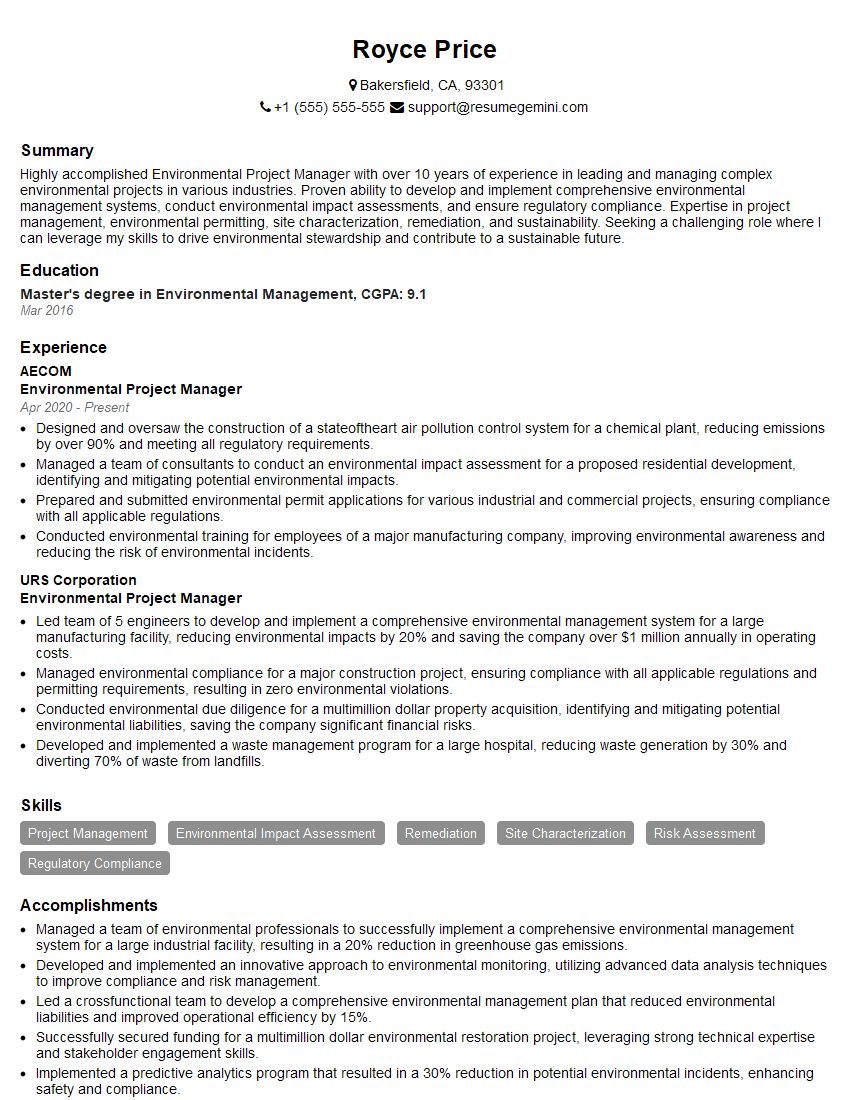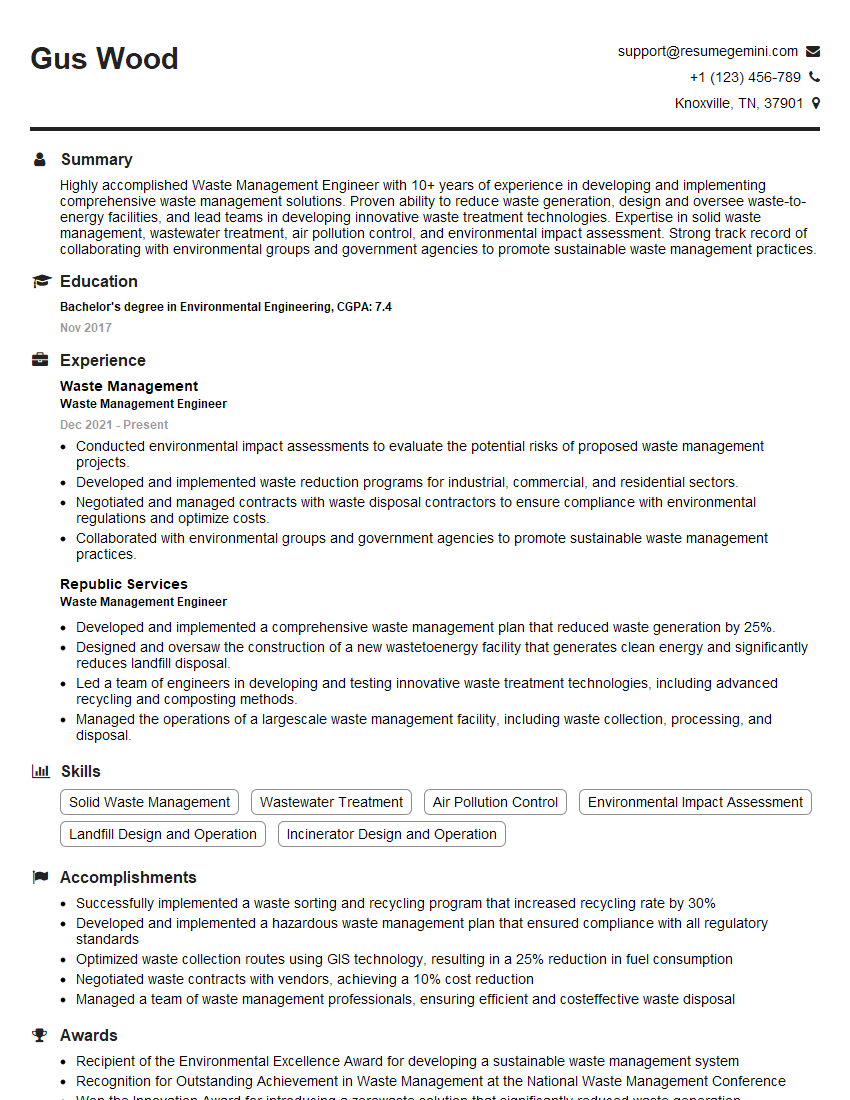The right preparation can turn an interview into an opportunity to showcase your expertise. This guide to Experience in waste reduction and sustainability initiatives interview questions is your ultimate resource, providing key insights and tips to help you ace your responses and stand out as a top candidate.
Questions Asked in Experience in waste reduction and sustainability initiatives Interview
Q 1. Describe your experience implementing a waste reduction program.
In my previous role at GreenTech Solutions, I spearheaded a comprehensive waste reduction program. We started by conducting a thorough waste audit to identify the types and quantities of waste generated across the organization. This involved visually inspecting waste streams, weighing waste, and analyzing waste composition. This data revealed that paper waste and single-use plastics were significant contributors.
Based on this audit, we implemented a multi-pronged approach. We initiated a company-wide recycling program with clearly labeled bins for paper, plastic, glass, and compostable materials. We also launched a campaign to promote the use of reusable mugs and water bottles, and we transitioned to compostable takeout containers in the company cafeteria. We further incentivized participation by recognizing teams and individuals with the lowest waste generation rates. The result was a 30% reduction in overall waste within the first year.
We also implemented a robust composting program. We partnered with a local composting facility, provided composting bins in offices and communal areas, and educated employees on what materials could be composted. This greatly reduced our landfill waste. We continuously monitored our progress through regular waste audits and adjusted our strategies as needed, for example, by introducing educational materials based on observed gaps in employee understanding of our recycling guidelines.
Q 2. What are the key metrics you use to measure the success of a sustainability initiative?
Measuring the success of a sustainability initiative requires a balanced scorecard approach, tracking both quantitative and qualitative metrics. Key quantitative metrics include:
- Waste Diversion Rate: Percentage of waste diverted from landfills through recycling, composting, and other means. A higher rate indicates greater success.
- Greenhouse Gas Emissions Reduction: Tracking reductions in carbon footprint associated with waste management and other sustainability efforts.
- Energy Consumption: Measuring reductions in energy usage through efficiency improvements.
- Water Consumption: Monitoring and reducing water usage throughout operations.
- Cost Savings: Calculating savings from waste reduction, increased efficiency, and reduced resource consumption.
Qualitative metrics are equally important and help provide context:
- Employee Engagement: Measuring participation rates in sustainability initiatives through surveys and feedback.
- Stakeholder Satisfaction: Assessing the perception of sustainability efforts among employees, customers, and the community.
- Compliance with Regulations: Ensuring adherence to environmental regulations and reporting requirements.
By combining quantitative and qualitative data, we can gain a holistic view of the program’s effectiveness and areas for improvement.
Q 3. Explain your understanding of Life Cycle Assessment (LCA).
Life Cycle Assessment (LCA) is a standardized methodology used to evaluate the environmental impacts of a product or service throughout its entire life cycle, from raw material extraction to disposal. It’s a cradle-to-grave analysis, considering impacts like energy consumption, greenhouse gas emissions, water usage, and waste generation at each stage.
An LCA typically involves four phases:
- Goal and Scope Definition: Defining the objectives of the LCA and outlining the boundaries of the study.
- Inventory Analysis: Quantifying the inputs and outputs associated with each life cycle stage.
- Impact Assessment: Evaluating the environmental impacts of the inputs and outputs identified in the inventory analysis.
- Interpretation: Analyzing the results and drawing conclusions about the overall environmental performance of the product or service.
For example, an LCA might compare the environmental impact of a paper cup versus a reusable coffee cup, considering factors like manufacturing, transportation, usage, cleaning, and disposal. The results would reveal which option has a lower overall environmental footprint.
Q 4. How would you approach reducing plastic waste within an organization?
Reducing plastic waste within an organization requires a multi-faceted strategy. First, a comprehensive audit would identify the types and quantities of plastic waste generated. This could involve reviewing purchasing records, conducting waste audits, and interviewing employees.
Based on the audit findings, we’d prioritize actions like:
- Switching to Reusable Alternatives: Replacing single-use plastic items like water bottles, cutlery, and coffee cups with reusable alternatives. This often involves providing employees with reusable options and offering incentives to encourage their use.
- Reducing Packaging: Negotiating with suppliers to reduce or eliminate plastic packaging on products. This might involve exploring bulk purchasing or products with minimal packaging.
- Improving Recycling Programs: Implementing effective recycling programs with clearly labeled bins and regular collection. Employee education is crucial here, making sure everyone understands what can and can’t be recycled.
- Promoting Composting: Where appropriate, promoting the composting of food waste and other organic materials to further reduce reliance on landfills.
- Working with Vendors: Engaging with vendors to source products with less plastic packaging or made from recycled materials.
- Advocating for Policy Changes: If feasible, advocating for company-wide policies promoting the use of sustainable materials and waste reduction strategies.
Regular monitoring and adjustments based on the results of waste audits would be essential to ensure the effectiveness of the strategy.
Q 5. What are some common barriers to implementing sustainable practices, and how can they be overcome?
Common barriers to implementing sustainable practices include:
- High Upfront Costs: Sustainable options often have higher initial costs, which can deter organizations with limited budgets.
- Lack of Awareness and Knowledge: Employees may not be aware of the benefits of sustainable practices or how to implement them effectively.
- Lack of Management Support: Without leadership buy-in and support, sustainability initiatives often fail to gain traction.
- Resistance to Change: Employees may resist changes to established procedures, hindering the adoption of new sustainable practices.
- Lack of Measurable Metrics: Without clear metrics to track progress, it can be difficult to demonstrate the success of sustainability initiatives.
Overcoming these barriers requires a comprehensive approach:
- Demonstrate ROI: Showcasing the long-term cost savings and other benefits of sustainable practices to secure buy-in from management.
- Education and Training: Providing employees with training and resources to understand and implement sustainable practices.
- Incentivizing Participation: Offering rewards or recognition for employees who participate in sustainability initiatives.
- Phased Implementation: Implementing sustainable practices gradually to minimize disruption and allow for adjustments.
- Clear Communication: Effectively communicating the goals and benefits of sustainability initiatives to all stakeholders.
Q 6. Describe your experience with different waste sorting and recycling methods.
My experience encompasses several waste sorting and recycling methods, including:
- Single-Stream Recycling: This method involves combining various recyclable materials (paper, plastic, glass, metal) into a single bin for collection, simplifying the process for users but potentially requiring more sophisticated sorting facilities.
- Dual-Stream Recycling: This separates recyclables into two streams – paper/cardboard and containers (plastic, glass, metal). It typically results in higher recycling rates than single-stream due to reduced contamination.
- Source Separation: This involves separating waste at its source, such as having separate bins for different types of recyclables and compostable materials. It minimizes contamination and maximizes recycling efficiency but requires more space and user engagement.
- Mechanical Separation: This utilizes automated equipment (like conveyor belts, magnets, and eddy current separators) to separate recyclables at a materials recovery facility. It is efficient for large volumes of waste but may have limitations with complex materials.
- Manual Sorting: This involves hand-sorting of recyclables, often used for smaller-scale operations or to handle materials that are difficult to separate mechanically.
The optimal method depends on factors like the volume and composition of waste, available resources, and local regulations.
Q 7. How familiar are you with ISO 14001 environmental management standards?
I am very familiar with ISO 14001, the internationally recognized standard for environmental management systems. It provides a framework for organizations to establish, implement, maintain, and improve their environmental performance. The standard covers various aspects of environmental management, including:
- Environmental Policy: Defining the organization’s commitment to environmental protection.
- Environmental Aspects and Impacts: Identifying and evaluating environmental aspects of operations.
- Legal and Other Requirements: Ensuring compliance with relevant environmental regulations.
- Environmental Objectives and Targets: Setting measurable goals for environmental improvement.
- Operational Control: Implementing processes to prevent pollution and manage environmental risks.
- Emergency Preparedness and Response: Developing plans for responding to environmental emergencies.
- Monitoring and Measurement: Tracking environmental performance through data collection and analysis.
- Management Review: Regularly assessing the effectiveness of the environmental management system.
ISO 14001 certification demonstrates an organization’s commitment to environmental responsibility and can provide a competitive advantage. My experience includes working with organizations to implement and maintain ISO 14001-compliant systems, ensuring compliance with all requirements and fostering a culture of continuous improvement in environmental performance.
Q 8. What strategies have you used to engage employees in sustainability initiatives?
Engaging employees in sustainability initiatives requires a multi-pronged approach that moves beyond simple compliance. It’s about fostering a culture of ownership and responsibility.
- Education and Awareness: We start with comprehensive training, explaining the ‘why’ behind our efforts – the environmental impact, cost savings, and reputational benefits. For example, I’ve used interactive workshops, videos, and gamified challenges to make learning engaging and memorable.
- Incentives and Recognition: We implement reward systems acknowledging individual and team achievements. This could involve gift cards, public recognition, or even extra time off. In one project, we implemented a points-based system where employees earned points for sustainable actions, which could be redeemed for prizes.
- Empowerment and Involvement: Employees should feel empowered to contribute. We establish employee-led green teams that brainstorm ideas, implement initiatives, and track progress. This fosters ownership and creative problem-solving. For instance, a green team at a previous company developed a successful composting program, reducing landfill waste significantly.
- Transparent Communication: Regularly communicating progress and achievements through newsletters, intranet posts, and meetings is crucial. This keeps employees informed and reinforces the importance of their contributions.
- Leadership Buy-in: Visible support from senior management is paramount. Leaders must champion sustainability initiatives and actively participate in them, modeling the desired behavior.
By combining these strategies, we build a strong culture of sustainability where employees feel valued, informed, and motivated to contribute.
Q 9. How do you identify and prioritize waste reduction opportunities?
Identifying and prioritizing waste reduction opportunities is a systematic process. I typically use a combination of qualitative and quantitative methods:
- Waste Audits: This is the cornerstone. We conduct thorough waste audits—a detailed analysis of the type, quantity, and source of waste generated. This might involve manually sorting waste streams or using specialized software to track waste generation over time. This provides the data we need for informed decision making.
- Data Analysis: Following the audit, we analyze the data to identify waste ‘hotspots’ – areas producing the most waste or specific types of waste with high reduction potential. We use charts, graphs, and statistical analysis to visualize the data and easily identify patterns.
- Prioritization Matrix: Based on the analysis, we utilize a prioritization matrix. We might consider factors like the quantity of waste, the ease of implementation, the cost-effectiveness of interventions, and the environmental impact. This helps us focus our resources on the most impactful opportunities first.
- Stakeholder Input: We engage with relevant stakeholders—employees, management, and external consultants—to gather perspectives and identify potential challenges or opportunities.
For example, in a previous role, a waste audit revealed that a significant portion of waste stemmed from packaging. This led us to prioritize sourcing sustainable packaging alternatives, resulting in a substantial reduction in waste and improved our environmental footprint.
Q 10. Explain your understanding of circular economy principles.
The circular economy is an economic model that aims to minimize waste and maximize resource utilization. Unlike the traditional linear ‘take-make-dispose’ model, it focuses on keeping resources in use for as long as possible, extracting maximum value from them, then recovering and regenerating products and materials at the end of each service life.
Key principles include:
- Design out waste and pollution: Products and processes are designed to minimize waste and pollution from the outset.
- Keep products and materials in use: Strategies like reuse, repair, and refurbishment extend the lifespan of products.
- Regenerate natural systems: Waste is viewed as a resource, and processes are designed to recover and regenerate materials, mimicking natural cycles.
Imagine a clothing company implementing a circular economy model. They would design durable, repairable clothing, offer repair services, and establish take-back programs to recycle or upcycle old garments into new products. This reduces reliance on virgin materials and minimizes textile waste in landfills.
Q 11. What are the key differences between recycling, composting, and landfilling?
Recycling, composting, and landfilling are all waste disposal methods, but they differ significantly in their environmental impact and the types of waste they handle:
- Recycling: The process of converting waste materials into new products. It reduces the demand for virgin materials and conserves natural resources. Examples include recycling paper, plastic, glass, and metals.
- Composting: The controlled decomposition of organic matter (food scraps, yard waste) by microorganisms. It produces nutrient-rich compost, which can be used as a soil amendment, reducing the need for synthetic fertilizers. Composting diverts organic waste from landfills, reducing greenhouse gas emissions.
- Landfilling: The disposal of waste in landfills, where it is buried. This method is often the least environmentally friendly because it contributes to greenhouse gas emissions (methane), leachate (contaminant-rich water), and soil and groundwater contamination.
The key difference lies in their resource recovery potential. Recycling and composting actively recover resources and create value, whereas landfilling simply buries waste, often resulting in environmental damage.
Q 12. How would you calculate the ROI of a waste reduction project?
Calculating the ROI (Return on Investment) of a waste reduction project involves comparing the costs of implementation against the financial benefits achieved. This can include both direct and indirect cost savings.
Steps to Calculate ROI:
- Calculate Total Project Costs: This includes the initial investment (equipment, software, training), ongoing operational costs (labor, materials), and any other related expenses.
- Calculate Total Savings: This involves identifying all cost reductions associated with the project. This could include reduced waste disposal fees, lower material costs due to recycling or reuse, reduced energy consumption, and improved operational efficiency.
- Calculate Net Savings: Subtract the total project costs from the total savings.
- Calculate ROI: Divide the net savings by the total project costs, and multiply by 100% to express it as a percentage.
ROI = (Total Savings - Total Costs) / Total Costs * 100%
For example, a project reducing landfill waste by 20% might yield significant savings in disposal fees. These savings, along with potential cost reductions from material reuse or recycling, would be factored into the ROI calculation. It’s crucial to consider both quantifiable financial benefits and potential indirect benefits such as improved brand reputation and regulatory compliance. A strong ROI calculation provides compelling evidence for future sustainability investments.
Q 13. Describe your experience with waste audits and data analysis.
Waste audits and data analysis are crucial for effective waste management. My experience involves both conducting audits and interpreting the resulting data to inform strategic decision-making.
Waste Audits: I’ve led numerous waste audits, using various methodologies, from manual sorting of waste streams to employing specialized software for real-time waste tracking. This has involved working with teams to develop detailed audit plans, collecting data accurately, and ensuring data integrity. For example, in a recent audit of an office building, we meticulously documented the weight and composition of waste from various sources (offices, cafeteria, restrooms).
Data Analysis: Once the data is collected, I use various analytical tools—spreadsheets, statistical software, and data visualization tools—to analyze the results. This helps us identify waste hotspots, quantify waste reduction opportunities, and monitor progress over time. We use different visual tools, such as pie charts to illustrate waste composition, bar graphs to show waste trends over time and maps to pinpoint the location of high waste areas. This analysis provides crucial insights for developing targeted interventions and measuring the effectiveness of waste reduction strategies.
For instance, the office building audit revealed that paper waste was the largest component of the total waste. This insight led us to implement strategies such as promoting digital document management and introducing double-sided printing to reduce paper consumption.
Q 14. What are some innovative technologies used in waste management?
Innovative technologies are transforming waste management, offering more efficient and sustainable solutions:
- Artificial Intelligence (AI) and Machine Learning (ML): AI and ML algorithms are used in waste sorting facilities to automatically identify and sort different types of waste, increasing efficiency and accuracy. This improves recycling rates and reduces contamination.
- Robotics and Automation: Robots are being deployed in waste sorting plants and recycling facilities to automate tasks, improving efficiency, reducing labor costs, and minimizing human exposure to hazardous materials.
- Anaerobic Digestion: This technology breaks down organic waste in the absence of oxygen, producing biogas (renewable energy) and digestate (a fertilizer). It reduces landfill burden and generates renewable energy.
- Advanced Recycling Technologies: Technologies like chemical recycling and pyrolysis offer new ways to process complex waste streams, such as plastics, which are difficult to recycle using traditional methods.
- Smart Bins and Waste Sensors: These technologies provide real-time data on waste levels, helping optimize waste collection routes and prevent overflowing bins. This improves efficiency and reduces collection costs.
These technologies are improving the efficiency and environmental performance of waste management systems and offer promising solutions for tackling the global waste challenge. For example, the implementation of smart bins in a city can optimize waste collection routes, leading to significant cost savings and reduced carbon emissions.
Q 15. How do you stay current with the latest trends in sustainability and waste reduction?
Staying current in the dynamic fields of sustainability and waste reduction requires a multi-pronged approach. I actively engage with several key resources. This includes subscribing to leading journals like Waste Management and Resources, Conservation & Recycling, attending industry conferences such as the Waste Management & Recycling Conference & Expo, and participating in online communities and forums focused on sustainability best practices. I also follow influential experts and organizations in the field on platforms like LinkedIn and Twitter, keeping abreast of emerging research and innovative solutions. For example, recently I learned about a new enzymatic process for breaking down plastics, a significant advancement in tackling plastic waste. Finally, I regularly review reports and publications from organizations like the EPA and the Ellen MacArthur Foundation to stay informed about evolving regulations and industry trends.
Career Expert Tips:
- Ace those interviews! Prepare effectively by reviewing the Top 50 Most Common Interview Questions on ResumeGemini.
- Navigate your job search with confidence! Explore a wide range of Career Tips on ResumeGemini. Learn about common challenges and recommendations to overcome them.
- Craft the perfect resume! Master the Art of Resume Writing with ResumeGemini’s guide. Showcase your unique qualifications and achievements effectively.
- Don’t miss out on holiday savings! Build your dream resume with ResumeGemini’s ATS optimized templates.
Q 16. Explain your experience with developing and implementing a sustainability policy.
In my previous role at [Previous Company Name], I led the development and implementation of a comprehensive sustainability policy. The process started with a thorough materiality assessment, identifying key environmental impacts related to our operations, such as energy consumption, waste generation, and water usage. This assessment involved analyzing our supply chain, production processes, and product lifecycle. Based on this assessment, we established specific, measurable, achievable, relevant, and time-bound (SMART) targets for reducing our environmental footprint. For instance, we aimed to reduce landfill waste by 25% within three years. The policy included detailed procedures for waste segregation, recycling, and responsible disposal, along with employee training programs to ensure compliance. We also integrated sustainability metrics into our key performance indicators (KPIs), holding departments accountable for their environmental performance. Regular reporting and progress reviews were crucial to track our achievements and identify areas needing improvement. The policy’s success was evident in our significant reduction in waste generation and improved overall environmental performance.
Q 17. How would you manage conflicts between environmental goals and operational efficiency?
Balancing environmental goals with operational efficiency often presents challenges. My approach is to view them not as conflicting forces, but as interconnected aspects of long-term business success. I employ a strategic framework that prioritizes finding synergistic solutions. This involves using tools like Life Cycle Assessments (LCAs) to evaluate the environmental impact of different operational choices. For example, if investing in a new energy-efficient machine increases upfront costs but drastically reduces long-term energy consumption and waste, the LCA can help quantify the overall environmental and economic benefits. Further, open communication and collaboration are vital. I work with operations teams to explore innovative solutions that improve efficiency while minimizing environmental impact. This might involve implementing lean manufacturing principles to reduce waste, investing in renewable energy sources, or exploring circular economy models to minimize material use and maximize resource recovery. Ultimately, a well-defined sustainability strategy should demonstrate how environmental stewardship contributes to improved operational performance, long-term cost savings, and enhanced brand reputation.
Q 18. What are your thoughts on extended producer responsibility (EPR)?
Extended Producer Responsibility (EPR) is a crucial policy instrument for promoting sustainable product design and waste management. It holds producers responsible for the end-of-life management of their products, incentivizing them to design more sustainable products with recyclability and reduced environmental impact in mind. I believe EPR is an essential step towards a circular economy, shifting the focus from linear ‘take-make-dispose’ models to closed-loop systems where materials are reused and recycled. Successfully implementing EPR requires clear regulations, effective monitoring mechanisms, and collaborative efforts between producers, recyclers, and governments. For example, a well-designed EPR program for electronics could incentivize manufacturers to use easily separable materials, facilitating better recycling rates and reducing e-waste in landfills. However, it’s also important to consider the potential impacts on smaller businesses and the need for fair and equitable implementation to avoid unintended consequences.
Q 19. How do you ensure compliance with environmental regulations?
Ensuring compliance with environmental regulations is paramount. My approach is proactive rather than reactive. This involves a thorough understanding of all applicable local, national, and international regulations related to waste management and environmental protection. We use a combination of internal audits, regular compliance checks, and external expert reviews to identify potential gaps and address them swiftly. We also invest in ongoing training for our staff to keep them informed about updated regulations and best practices. Maintaining comprehensive documentation of all waste management activities and environmental permits is crucial for demonstrating compliance. Furthermore, establishing a robust system for tracking, reporting, and verifying environmental data ensures transparency and accountability. If a non-compliance issue arises, I would immediately implement corrective actions, document the process, and learn from the incident to prevent future occurrences. This detailed, proactive approach helps minimize risks and maintain a strong record of environmental compliance.
Q 20. Describe your experience working with stakeholders to achieve sustainability goals.
Effective stakeholder engagement is fundamental to achieving sustainability goals. My experience shows that success requires building strong relationships and fostering open communication with various stakeholders, including employees, suppliers, customers, regulators, and community groups. I believe in collaborative approaches, facilitating workshops and dialogues to understand diverse perspectives and build consensus around shared objectives. Transparent communication regarding our sustainability efforts, including challenges and successes, helps build trust and accountability. For example, in one project, we worked closely with a local community group to design a composting program for organic waste, addressing their concerns about odor and potential environmental impacts. This collaborative effort not only improved our waste management but also strengthened community relationships and enhanced our reputation for environmental responsibility. Ultimately, successful stakeholder engagement fosters a shared sense of ownership and commitment towards common sustainability goals.
Q 21. How familiar are you with different waste streams (e.g., organic, hazardous)?
I have extensive experience working with diverse waste streams. This includes organic waste (food scraps, yard waste, etc.), which can be managed through composting, anaerobic digestion, or other appropriate methods. I understand the importance of proper segregation and handling of hazardous waste (chemicals, batteries, medical waste), which require specialized disposal methods to prevent environmental contamination. I’m also knowledgeable about recyclable materials (paper, plastics, metals, glass), the different recycling processes, and the market dynamics for recycled materials. In addition to these common waste streams, I am familiar with construction and demolition waste, electronic waste (e-waste), and other specialized waste streams. My experience encompasses the development and implementation of waste management plans, including waste audits, waste reduction strategies, and the selection of appropriate disposal and recycling options tailored to the specific characteristics of each waste stream. Understanding the unique properties and management requirements of different waste streams is essential for maximizing resource recovery and minimizing environmental impact.
Q 22. How would you address a sudden increase in waste generation?
A sudden increase in waste generation requires a rapid, multi-pronged approach. First, we need to understand the cause. Is it seasonal fluctuation, a change in production methods, or a new product launch? A thorough waste audit is crucial – meticulously categorizing waste streams to pinpoint the source of the increase. This audit might involve visual inspections, weighings, and even waste composition analysis.
Once the cause is identified, we implement targeted interventions. For example, if the increase stems from inefficient packaging, we might explore alternatives like reusable containers or optimized packaging designs. If it’s due to increased production, we might focus on improving processes to reduce waste at the source, like implementing lean manufacturing principles. We’d also reinforce existing waste reduction programs, perhaps through additional training for employees or improved signage to promote proper waste segregation.
Finally, effective communication is key. Keeping stakeholders informed about the situation and the actions being taken helps maintain buy-in and transparency. Regular progress reports demonstrate accountability and show that we’re actively tackling the issue.
Q 23. What are your preferred methods for communicating sustainability progress?
Communicating sustainability progress involves a balanced approach targeting different audiences. Data visualization is paramount; graphs and charts make complex information easily digestible. We could use dashboards to track key performance indicators (KPIs) in real-time, showcasing improvements in waste diversion rates, reduced energy consumption, or decreased carbon emissions. These dashboards should be accessible to all employees, fostering a culture of sustainability.
Beyond dashboards, we leverage storytelling. Success stories highlighting individual or team contributions are shared internally through newsletters, team meetings, and presentations. Externally, we might utilize case studies, press releases, or sustainability reports to demonstrate our commitment to stakeholders, including investors, customers, and the wider community. Regular updates on social media platforms can also keep the dialogue open and foster engagement.
Q 24. How do you measure and report on Key Performance Indicators (KPIs) related to waste reduction?
Measuring and reporting KPIs for waste reduction necessitates a robust system. We start by establishing clear, measurable targets, such as reducing waste by a specific percentage annually. Then, we collect data consistently and accurately – using weight measurements, volume calculations, and waste audits to track key metrics. These might include waste diversion rates (percentage of waste diverted from landfills), recycling rates, and the amount of hazardous waste generated.
I favor using software for data management and reporting. This allows for automated calculations, trend analysis, and the creation of visually appealing reports. These reports are presented regularly, perhaps monthly or quarterly, to management and relevant stakeholders. They should clearly show progress against targets, highlight areas for improvement, and identify any unexpected trends. Crucially, we need to regularly review and refine our KPI tracking system to ensure it remains relevant and effective.
Q 25. What is your understanding of carbon footprint reduction strategies?
Carbon footprint reduction strategies are multifaceted and interconnected. They begin with a comprehensive assessment – identifying sources of greenhouse gas (GHG) emissions within the organization. This might involve energy use, transportation, waste management, and even the supply chain. Once identified, we prioritize reduction efforts based on their impact and feasibility.
Strategies could include energy efficiency improvements (e.g., switching to LED lighting, improving building insulation), transitioning to renewable energy sources (e.g., solar panels, wind power), optimizing transportation routes to reduce fuel consumption, implementing waste reduction programs to minimize methane emissions from landfills, and engaging with suppliers to promote sustainable practices throughout the supply chain. Carbon offsetting, while not a replacement for reduction, might be considered as a supplementary strategy.
Regular monitoring and reporting are vital, using tools like carbon accounting software to track progress against targets and identify opportunities for further improvement. The ultimate goal is to minimize the organization’s environmental footprint and contribute to a low-carbon economy.
Q 26. Explain your approach to designing and implementing a waste minimization program for a specific industry.
Designing and implementing a waste minimization program for a specific industry starts with a deep understanding of that industry’s unique challenges. For example, a food processing plant will have different waste streams than a manufacturing facility. The program would involve a thorough assessment of waste generation points, types of waste produced, and current waste management practices.
Next, we identify opportunities for waste reduction at the source – this could be redesigning packaging, implementing lean manufacturing techniques, optimizing production processes, or improving product design to reduce material use. We might then explore ways to recycle or reuse materials – creating closed-loop systems where possible. Improved waste segregation, providing adequate training to employees, and installing appropriate waste handling equipment are also essential.
The program’s success is measured through KPIs such as waste diversion rates, reduction in waste disposal costs, and improvements in resource efficiency. Regular monitoring and adjustments are crucial to optimize performance and adapt to changing circumstances. Effective communication is vital throughout the process, engaging employees and stakeholders to foster a culture of continuous improvement.
Q 27. How would you incorporate sustainability principles into the procurement process?
Incorporating sustainability principles into procurement involves evaluating suppliers based on their environmental performance. This goes beyond simply looking at price and quality. We would assess suppliers’ commitment to reducing their carbon footprint, using sustainable materials, and adhering to ethical labor practices. This could involve requesting environmental impact statements, conducting supplier audits, and using standardized sustainability rating systems.
We’d prioritize suppliers who demonstrate a commitment to reducing waste, using recycled materials, and minimizing their environmental impact throughout their supply chain. We could incentivize sustainable practices by offering preferential treatment to suppliers who meet our sustainability criteria. This could involve longer-term contracts, higher order volumes, or preferential pricing. Transparency is essential – regularly communicating sustainability expectations to suppliers and monitoring their performance.
Q 28. Describe your experience with developing and delivering sustainability training programs.
I have extensive experience developing and delivering sustainability training programs. These programs are tailored to the specific needs and knowledge levels of the target audience. For instance, a program for senior management might focus on strategic sustainability planning, while a program for production line workers could focus on practical waste reduction techniques.
The programs typically incorporate interactive elements, such as workshops, group discussions, and case studies to foster engagement and knowledge retention. They might include practical demonstrations of waste reduction techniques or visits to recycling facilities. Post-training assessments help measure the effectiveness of the training and identify areas for improvement. Following the training, ongoing support and reinforcement are crucial to ensure the program’s long-term impact. This includes regular communication, updated resources, and opportunities for employees to share their experiences and best practices.
Key Topics to Learn for Experience in Waste Reduction and Sustainability Initiatives Interview
- Waste Audits and Assessments: Understanding methodologies for conducting waste audits, analyzing data to identify waste streams, and quantifying reduction opportunities. Practical application: Describe your experience in designing and implementing a waste audit, including the tools and techniques used.
- Waste Reduction Strategies: Familiarize yourself with various waste reduction strategies, including source reduction, reuse, recycling, composting, and energy recovery. Practical application: Discuss your involvement in implementing specific waste reduction strategies, highlighting the results achieved and challenges overcome.
- Sustainable Procurement: Learn about environmentally responsible purchasing practices, including lifecycle assessments and the selection of sustainable products and services. Practical application: Detail your experience in influencing procurement decisions towards more sustainable options.
- Stakeholder Engagement and Communication: Understand the importance of effective communication and collaboration with stakeholders (employees, clients, community) to drive sustainability initiatives. Practical application: Describe your role in engaging stakeholders and building consensus around sustainability goals.
- Metrics and Reporting: Mastering the use of key performance indicators (KPIs) to track progress, measure success, and demonstrate the impact of sustainability initiatives. Practical application: Showcase your experience in developing and presenting sustainability reports.
- Lifecycle Assessment (LCA): Understanding the principles of LCA and its application in evaluating the environmental impacts of products and processes. Practical application: Discuss any experience conducting or utilizing LCA data to inform decision-making.
- Circular Economy Principles: Demonstrate knowledge of the circular economy and its application in reducing waste and promoting resource efficiency. Practical application: Provide examples of how you have incorporated circular economy principles into your work.
Next Steps
Mastering these topics will significantly enhance your interview performance and demonstrate your commitment to a sustainable future, opening doors to exciting career opportunities in a growing field. Creating a strong, ATS-friendly resume is crucial for maximizing your job prospects. ResumeGemini is a trusted resource that can help you craft a compelling and effective resume tailored to your experience in waste reduction and sustainability initiatives. Examples of resumes specifically designed for this field are available to guide you. Invest time in crafting a professional and impactful resume—it’s your first impression on potential employers.
Explore more articles
Users Rating of Our Blogs
Share Your Experience
We value your feedback! Please rate our content and share your thoughts (optional).
What Readers Say About Our Blog
Interesting Article, I liked the depth of knowledge you’ve shared.
Helpful, thanks for sharing.
Hi, I represent a social media marketing agency and liked your blog
Hi, I represent an SEO company that specialises in getting you AI citations and higher rankings on Google. I’d like to offer you a 100% free SEO audit for your website. Would you be interested?
